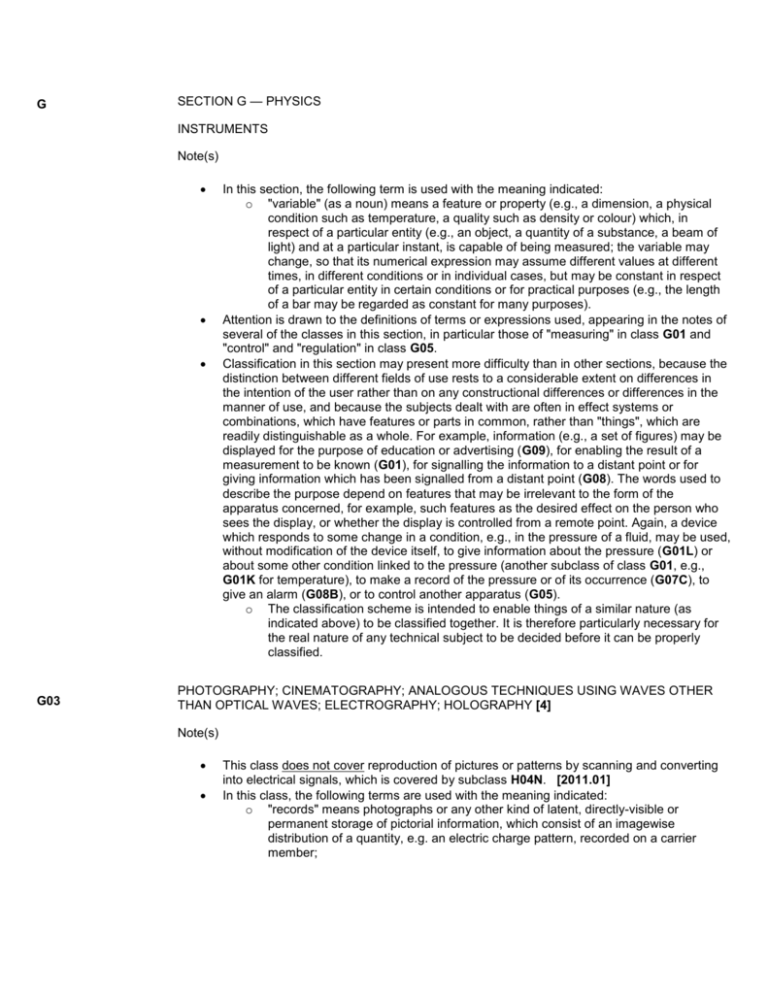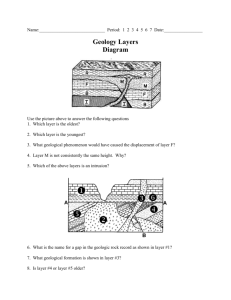WIPO IPC: Internet Publication
advertisement

G SECTION G — PHYSICS INSTRUMENTS Note(s) G03 In this section, the following term is used with the meaning indicated: o "variable" (as a noun) means a feature or property (e.g., a dimension, a physical condition such as temperature, a quality such as density or colour) which, in respect of a particular entity (e.g., an object, a quantity of a substance, a beam of light) and at a particular instant, is capable of being measured; the variable may change, so that its numerical expression may assume different values at different times, in different conditions or in individual cases, but may be constant in respect of a particular entity in certain conditions or for practical purposes (e.g., the length of a bar may be regarded as constant for many purposes). Attention is drawn to the definitions of terms or expressions used, appearing in the notes of several of the classes in this section, in particular those of "measuring" in class G01 and "control" and "regulation" in class G05. Classification in this section may present more difficulty than in other sections, because the distinction between different fields of use rests to a considerable extent on differences in the intention of the user rather than on any constructional differences or differences in the manner of use, and because the subjects dealt with are often in effect systems or combinations, which have features or parts in common, rather than "things", which are readily distinguishable as a whole. For example, information (e.g., a set of figures) may be displayed for the purpose of education or advertising (G09), for enabling the result of a measurement to be known (G01), for signalling the information to a distant point or for giving information which has been signalled from a distant point (G08). The words used to describe the purpose depend on features that may be irrelevant to the form of the apparatus concerned, for example, such features as the desired effect on the person who sees the display, or whether the display is controlled from a remote point. Again, a device which responds to some change in a condition, e.g., in the pressure of a fluid, may be used, without modification of the device itself, to give information about the pressure (G01L) or about some other condition linked to the pressure (another subclass of class G01, e.g., G01K for temperature), to make a record of the pressure or of its occurrence (G07C), to give an alarm (G08B), or to control another apparatus (G05). o The classification scheme is intended to enable things of a similar nature (as indicated above) to be classified together. It is therefore particularly necessary for the real nature of any technical subject to be decided before it can be properly classified. PHOTOGRAPHY; CINEMATOGRAPHY; ANALOGOUS TECHNIQUES USING WAVES OTHER THAN OPTICAL WAVES; ELECTROGRAPHY; HOLOGRAPHY [4] Note(s) This class does not cover reproduction of pictures or patterns by scanning and converting into electrical signals, which is covered by subclass H04N. [2011.01] In this class, the following terms are used with the meaning indicated: o "records" means photographs or any other kind of latent, directly-visible or permanent storage of pictorial information, which consist of an imagewise distribution of a quantity, e.g. an electric charge pattern, recorded on a carrier member; o G03G "optical" applies not only to visible light but also to ultra-violet or infra-red radiations. [4] ELECTROGRAPHY; ELECTROPHOTOGRAPHY; MAGNETOGRAPHY (information storage based on relative movement between record carrier and transducer G11B; static stores with means for writing-in or reading-out information G11C; recording of television signals H04N 5/76) Note(s) This subclass covers: o the production of permanent directly-visible pictures in conformity with an original picture or document, using an intermediate imagewise distribution of an electric or magnetic quantity, such as a charge pattern, an electric conductivity pattern, or a magnetic pattern; o the production of permanent directly-visible pictures using an intermediate imagewise distribution of an electric or magnetic quantity, when the origin and the way of generating said intermediate distribution are not relevant. This subclass does not cover: o use of electric signals for the transmission of the picture information from the original to the reproduction, i.e. pictorial communication, which is covered by subclass H04N; o production of pictures by heat patterns exclusively, not using an electrostatic or magnetic pattern, which is covered by group B41M 5/00; o production of prints by transferring ink from a printing form to a printing surface, without physical contact and using the force of an electrostatic field, which is covered by subclass B41M; o selective printing mechanisms characterised by the selective supply of electric current, or the selective application of magnetism or radiation, to a printing material or impression-transfer material, which are covered by groups B41J 2/385, B41J 2/435. [5] Subclass indexes ORIGINAL RECORDING, MEMBERS AND MATERIALS 5/00, 7/00, 9/00 ELECTROGRAPHIC PROCESSES AND APPARATUS Using a charge pattern 13/00, 15/00 Using patterns other than charge patterns 17/00 Using deformation of thermoplastic layers 16/00 PROCESSES AND APPARATUS USING MAGNETIC PATTERNS 19/00 DETAILS NOT OTHERWISE PROVIDED FOR 8/00, 11/00, 21/00 G03G 5/00 Recording-members for original recording by exposure e.g. to light, to heat, to electrons; Manufacture thereof; Selection of materials therefor (recording surfaces for measuring apparatus G01D 15/34; photosensitive materials for photographic purposes G03C) G03G 5/02 · Charge-receiving layers (G03G 5/153 takes precedence) [5] G03G 5/022 · · Layers for surface-deformation imaging, e.g. frost imaging [2] G03G 5/024 · · Photoelectret layers [2] G03G 5/026 · · Layers in which during the irradiation a chemical reaction occurs whereby electrically conductive patterns are formed in the layers, e.g. for chemixerography [2] G03G 5/028 · · Layers in which after being exposed to heat patterns electrically conductive patterns are formed in the layers, e.g. for thermoxerography [2] G03G 5/04 · · Photoconductive layers; Charge-generation layers or charge-transporting layers; Additives therefor; Binders therefor [2, 5] G03G 5/043 · · · Photoconductive layers characterised by having two or more layers or characterised by their composite structure [5] G03G 5/047 · · · · characterised by the charge-generation layers or charge-transporting layers [5] G03G 5/05 · · · Organic bonding materials; Methods for coating a substrate with a photoconductive layer; Inert supplements for use in photoconductive layers [2] G03G 5/06 · · · characterised by the photoconductive material being organic [5] G03G 5/07 · · · · Polymeric photoconductive materials [2] G03G 5/08 · · · characterised by the photoconductive material being inorganic [2, 5] G03G 5/082 · · · · and not being incorporated in a bonding material, e.g. vacuum deposited [2] G03G 5/085 · · · · and being incorporated in an inorganic bonding material, e.g. glass-like layers [2] G03G 5/087 · · · · and being incorporated in an organic bonding material [2] G03G 5/09 · · · Sensitisers or activators, e.g. dyestuffs (G03G 5/12 takes precedence) [2] G03G 5/10 · Bases for charge-receiving or other layers G03G 5/12 · Recording members for multicolour processes [2] G03G 5/14 · Inert intermediate or cover layers for charge- receiving layers (G03G 5/04 takes precedence) [2, 5] G03G 5/147 · · Cover layers [5] G03G 5/153 · Charge-receiving layers combined with additional photo- or thermo-sensitive, but not photoconductive, layers, e.g. silver-salt layers [5] G03G 5/16 · Layers for recording by changing the magnetic properties, e.g. for Curie-point-writing [3] G03G 7/00 Selection of materials for use in image-receiving members, i.e. for reversal by physical contact; Manufacture thereof (photosensitive materials for photographic purposes G03C) G03G 8/00 Layers covering the final reproduction, e.g. for protecting, for writing thereon [2] G03G 9/00 Developers [5] G03G 9/06 · the developer being electrolytic G03G 9/08 · with toner particles [2] Note(s) In groups G03G 9/083-G03G 9/12, in the absence of an indication to the contrary, classification is made in the last appropriate place. [5] G03G 9/083 · · Magnetic toner particles [5] G03G 9/087 · · Binders for toner particles [5] G03G 9/09 · · Colouring agents for toner particles [5] G03G 9/093 · · Encapsulated toner particles [5] G03G 9/097 · · Plasticisers; Charge controlling agents [5] G03G 9/10 · · characterised by carrier particles [2, 5] G03G 9/107 · · · having magnetic components [5] G03G 9/113 · · · having coatings applied thereto [5] G03G 9/12 · · in liquid developer mixtures [2] G03G 9/125 · · · characterised by the liquid [5] G03G 9/13 · · · characterised by polymer components [5] G03G 9/135 · · · characterised by stabiliser or charge-controlling agents [5] G03G 9/16 · Developers not provided for in groups G03G 9/06-G03G 9/135, e.g. solutions, aerosols [2] G03G 9/18 · · Differentially-wetting liquid developers [2] G03G 11/00 Selection of substances for use as fixing agents G03G 13/00 Electrographic processes using a charge pattern (G03G 15/00, G03G 16/00, G03G 17/00 take precedence) [2, 5] G03G 13/01 · for multicoloured copies [2] G03G 13/02 · Sensitising, i.e. laying-down a uniform charge (devices for corona discharge per seH01T 19/00) G03G 13/04 · Exposing, i.e. imagewise exposure by optically projecting the original image on a photoconductive recording material [6] G03G 13/045 · · Charging or discharging distinct portions of the charge pattern on the recording material, e.g. discharging non-image areas, contrast enhancement (G03G 13/34, G03G 15/36, G03G 21/06 take precedence) [6] G03G 13/05 · Imagewise charging, i.e. laying-down a charge in the configuration of an original image using a modulated stream of charged particles, e.g. of corona ions, modulated by a photoconductive control screen bearing a charge pattern or by optically activated charging means (using charging means controlled by electric image signals B41J) [6] G03G 13/054 · using X-rays, e.g. electroradiography [6] G03G 13/056 · using internal polarisation [2, 6] G03G 13/06 · Developing G03G 13/08 · · using a solid developer, e.g. powder developer G03G 13/09 · · · using magnetic brush [2] G03G 13/095 · · · Removing excess solid developer [6] G03G 13/10 · · using a liquid developer G03G 13/11 · · · Removing excess liquid developer, e.g. by heat [6] G03G 13/14 · Transferring a pattern to a second base G03G 13/16 · · of a toner pattern, e.g. a powder pattern G03G 13/18 · · of a charge pattern G03G 13/20 · Fixing, e.g. by using heat G03G 13/22 · Processes involving the combination of more than one step according to groups G03G 13/02G03G 13/20 (G03G 13/01 takes precedence) [2] G03G 13/23 · · specially adapted for copying both sides of an original or for copying on both sides of a recording or image-receiving material [6] G03G 13/24 · · whereby at least two steps are performed simultaneously [2] G03G 13/26 · for the production of printing plates for non-xerographic printing processes [2] G03G 13/28 · · Planographic printing plates [2] G03G 13/30 · · Hectographic masters [2] G03G 13/32 · · Relief printing plates [2] G03G 13/34 · Editing, i.e. producing a composite image by copying one or more original images or parts thereof [6] G03G 15/00 Apparatus for electrographic processes using a charge pattern (G03G 16/00, G03G 17/00 take precedence) [2, 5] Note(s) This group covers also processes in so far as they are characterised by the use or manipulation of apparatus classifiable per se in this group. G03G 15/01 · for producing multicoloured copies [2] G03G 15/02 · for laying down a uniform charge, e.g. for sensitising; Corona discharge devices (G03G 15/14 takes precedence) [6] G03G 15/04 · for exposing, i.e. imagewise exposure by optically projecting the original image on a photoconductive recording material [6] G03G 15/041 · · with variable magnification [6] G03G 15/043 · · with means for controlling illumination or exposure (G03G 15/041 takes precedence) [6] G03G 15/045 · · with means for charging or discharging distinct portions of the charge pattern on the recording material, e.g. for contrast enhancement or discharging non-image areas (G03G 15/36, G03G 21/06 take precedence) [6] G03G 15/047 · · · for discharging non-image areas [6] G03G 15/05 · for imagewise charging, e.g. photoconductive control screen, optically activated charging means (charging means controlled by electric image signals B41J) [6] G03G 15/054 · using X-rays, e.g. electroradiography [6] G03G 15/056 · using internal polarisation [2, 6] G03G 15/06 · for developing G03G 15/08 · · using a solid developer, e.g. powder developer G03G 15/09 · · · using magnetic brush [2] G03G 15/095 · · · Removing excess solid developer [6] G03G 15/10 · · using a liquid developer G03G 15/11 · · · Removing excess liquid developer e.g. by heat [6] G03G 15/14 · for transferring a pattern to a second base G03G 15/16 · · of a toner pattern, e.g. a powder pattern G03G 15/18 · · of a charge pattern G03G 15/20 · for fixing, e.g. by using heat G03G 15/22 · involving the combination of more than one step according to groups G03G 13/02-G03G 13/20 (G03G 15/01 takes precedence) [2] G03G 15/23 · · specially adapted for copying both sides of an original or for copying on both sides of a recording or image-receiving material [6] G03G 15/24 · · whereby at least two steps are performed simultaneously [2] G03G 15/26 · · in which the charge pattern is obtained by projection of the entire image, i.e. whole-frame projection (G03G 15/04 takes precedence) [2, 6] G03G 15/28 · · in which projection is obtained by line scanning (G03G 15/04 takes precedence) [2, 6] G03G 15/30 · · · in which projection is formed on a drum [2] G03G 15/32 · · in which the charge pattern is formed dotwise (G03G 15/04, G03G 15/05, G03G 15/34 take precedence) [2, 6] G03G 15/34 · · in which the powder image is formed directly on the recording material [6] G03G 15/36 · Editing, i.e. producing a composite image by copying one or more original images or parts thereof [6] G03G 16/00 Electrographic processes using deformation of thermoplastic layers (layers for surface-deformation imaging G03G 5/022); Apparatus therefor [2, 6] G03G 17/00 Electrographic processes using patterns other than charge patterns, e.g. an electric conductivity pattern; Processes involving a migration; e.g. photoelectrophoresis, photoelectrosolography; Processes involving a selective transfer, e.g. electrophoto-adhesive processes; Apparatus essentially involving a single such process [5] G03G 17/02 · with electrolytic development [2] G03G 17/04 · using photoelectrophoresis [2] G03G 17/06 · · Apparatus therefor [5] G03G 17/08 · using an electrophoto-adhesive process, e.g. manifold imaging [5] G03G 17/10 · using migration imaging, e.g. photoelectrosolography (G03G 17/04 takes precedence) [5] G03G 19/00 Processes using magnetic patterns; Apparatus therefor G03G 21/00 Arrangements not provided for by groups G03G 13/00-G03G 19/00, e.g. cleaning, elimination of residual charge [2] G03G 21/02 · Counting the number of copies; Billing [6] G03G 21/04 · Preventing copies being made of an original [6] G03G 21/06 · Eliminating residual charges from a reusable imaging member [6] G03G 21/08 · · using optical radiation [6] G03G 21/10 · Collecting or recycling waste developer [6] G03G 21/12 · · Toner waste containers [6] G03G 21/14 · Electronic sequencing control [6] G03G 21/16 · Mechanical means for facilitating the maintenance of the apparatus, e.g. modular arrangements [6] G03G 21/18 · · using a processing cartridge [6] G03G 21/20 · Humidity or temperature control [6]







